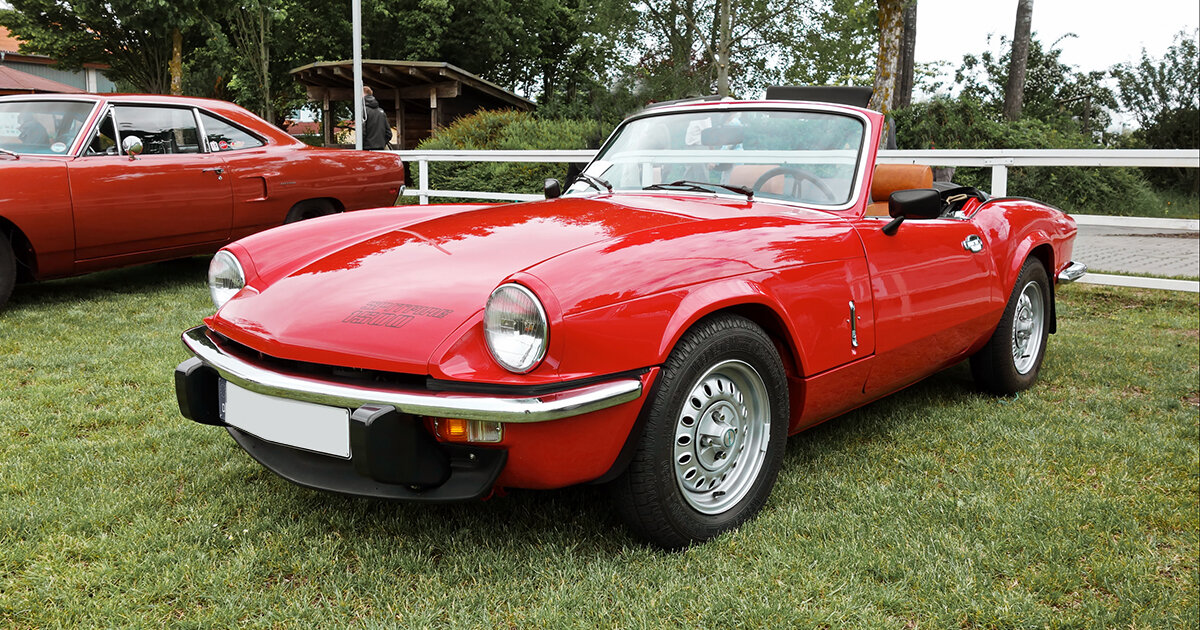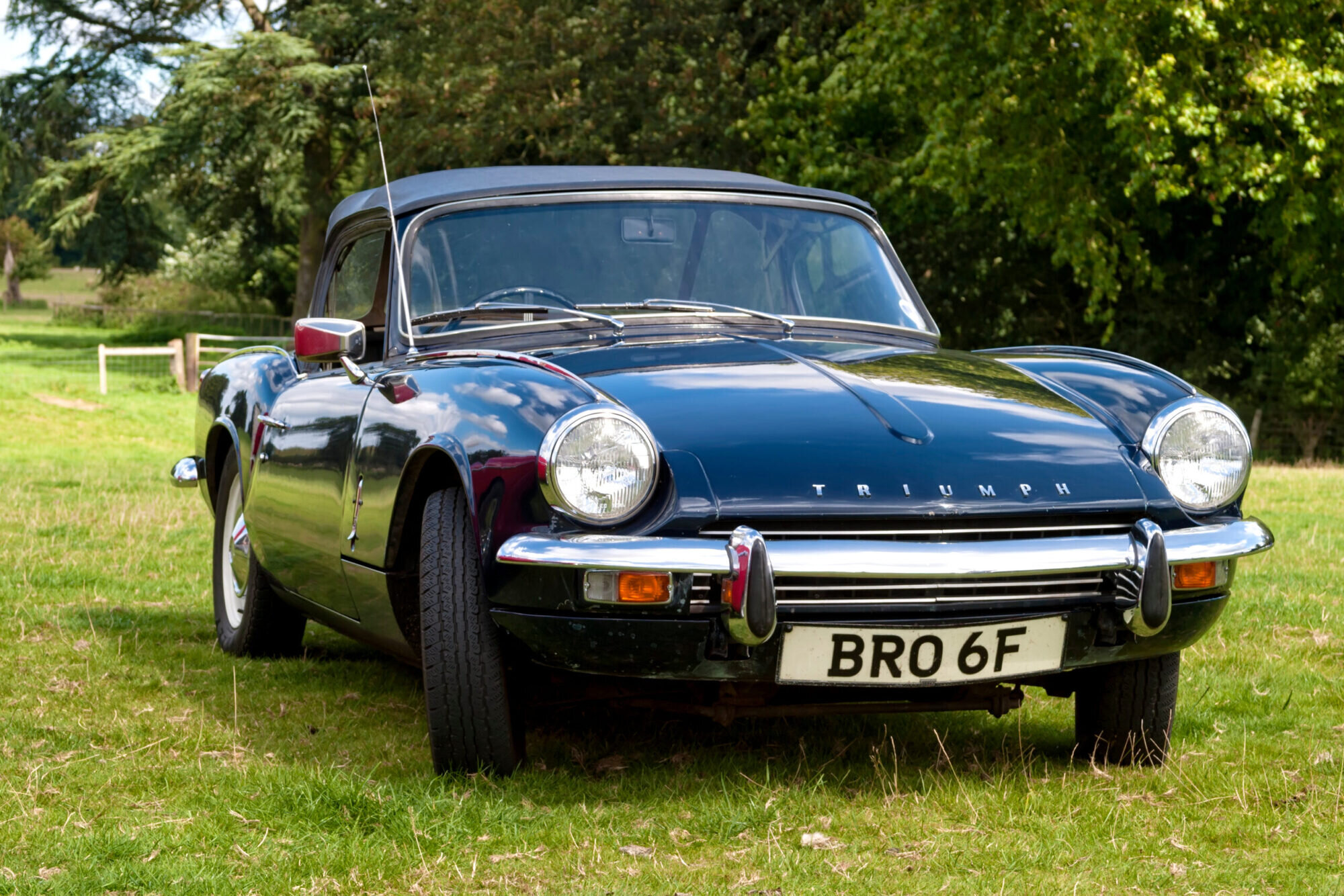The classic Triumph Spitfire was built for over 18 years, with 5 evolving models, from the Mark 1 through to the 1500. Stylish, trusted and uncomplicated, the Spitfire remains much-loved by classic sports car motoring enthusiasts.

Jump back in time
In 1940, the bombing effects of the Second World War ‘Blitz’ impacted the Triumph Motor Company and halted production with the company’s ‘Holbrook Lane’ works in Coventry, were completely destroyed by the German Luftwaffe aircraft.
Standard Motor Company purchased what was left of the Triumph Motor Company and the Triumph trade name in late 1944. In 1960, the Standard-Triumph company was then acquired by Leyland Motors, which created the opportunity to develop the Triumph Spitfire.
So how did the Triumph Spitfire get its name?
In the early 1960’s, the British aircraft company ‘Supermarine’, (most famous for mass-producing the Spitfire fighter plane during World War II) wanted to use the ‘Vanguard’ name for one of its passenger aircraft. The Standard Motor Company was already producing the Standard Vanguard car (1947 – 63). In exchange for being able to use the ‘Vanguard’ name, the aircraft company allowed the motor company to use the name of one of their aircraft. Hence, the Triumph Spitfire name was born.
The Timeline of the Triumph Spitfire
Production of the Triumph Spitfire, covering 5 different models, spanned from 1962 to 1980. With each version, the MK2 being an anomaly, the numbers built and sales increased.
1960 – The Beginning
Giovanni Michelotti made the prototype of the Spitfire under the codename of the ‘Bomb’ by using a shortened Herald chassis. It notably offered a ‘cockpit style’ driving experience with its low framework.
1962 – The MKI
The dainty Triumph Spitfire 4 or MK1 is brought to life and begins the Triumph Spitfire legacy. 45,753 were manufactured with the visionary Giovanni Michelotti driving the workforce.
1964 – Introducing the MKII
The Spitfire MKII is born with 37,408 produced. Adjustments were made to the performance and aesthetics including new carpets, a vinyl-trimmed dash, a subtle 67bhp, and tubular exhaust manifold. The MKII reached 0-60mph in 14 secs with a top speed of 94mph.
1967 – MKIII Evolution
The Spitfire MKIII saw the first major facelift. New crash regulations forced the company to raise the front bumper and front coil springs. Internally, the new wood-veneer interior finish provided a touch of class with the instrument cluster remaining centrally mounted for most of the MKIII range. In all 65,320 were built.

1970 – Popularity Drives MKIV
From 1969, the Spitfire had to provide headrests, another health and safety introduction. The car seats were redesigned, which were a welcome improvement, but the dashboard lost the wood veneer finish. The redesigned dashboard included a black plastic finish and instrumentation located directly in front of the driver, behind the steering wheel. All design changes reflected the growing popularity in the US, where sales accounted for 45% of Spitfire sales. 70,021 MKIV Spitfires were produced.
1974 – The Final Model
The final version of the Triumph Spitfire legacy, the 1500, was designed to be a small, affordable and fun-to-drive car. There were now options to purchase either a hard or soft top. The Spitfire engine was paired with a Morris Marina gearbox, pushing the top speed up to 100 mph (0-60mph in 13.4 seconds). 95,829 were made, the most of any model, before production ceased in 1980.
The Rivals
The Spitfire’s main rivals were from Austin-Healey and the MG Midget. The competition meant regular new designs and improvements were absolutely necessary. The fact that the Triumph Spitfire outsold MG Midgets every year of its production except one, highlight the popularity of the sports car.
Let’s talk numbers
0-60mph: 15.5-11.3 seconds
Top speed: 92-101mph
Mpg: 30-40
Production: 314,331 cars were produced under the Triumph Spitfire name.
On the Road Today
Only 22 MKI Triumph Spitfires remain licensed (2021). A good condition MK1 is valued at around £25,000. Just under 2000 Spitfire 1500s remain licensed (2021).
Interesting Fact
Hollywood actor Nicolas Cage’s first car was a Spitfire. A faded yellow classic roadster that sat in his garage, but in need of restoration.
Replacement SMITHS Gauges
SMITHS gauges for the Triumph Spitfire continue to be made at CAI’s manufacturing facility in the UK. The original drawings and tooling is used to ensure that these replacement gauges perfectly match the original gauges, ensuring that the dashboard appearance remains unaltered.
Related Articles
For further information on gauges for the Porsche 911 or any classic car, please contact us on:
Via the website
Email: [email protected]
Phone: +44 (0) 1639 732200



